Requirements
WideWorldImporters. You can download it on this link https://github.com/Microsoft/sql-server-samples/releases/tag/wide-world-importers-v1.0Sales.Orders using the code below:|
1 2 3 4 5 6 |
USE [WideWorldImporters] GO CREATE NONCLUSTERED INDEX [indPurchaseOrder] ON [Sales].[Orders] ( [customerpurchaseordernumber] ASC ) GO |
Prepare the Extended Events Session
|
1 2 3 4 5 6 7 8 9 10 11 12 13 14 15 16 17 18 |
USE master; GO IF EXISTS (SELECT * FROM sys.dm_xe_sessions WHERE NAME = 'query_antipattern_xe') BEGIN DROP event session [query_antipattern_xe] ON server; END GO CREATE EVENT SESSION [query_antipattern_xe] ON SERVER ADD EVENT sqlserver.query_antipattern ( ACTION(sqlserver.client_app_name,sqlserver.plan_handle, sqlserver.query_hash,sqlserver.query_plan_hash, sqlserver.sql_text) ) ADD TARGET package0.ring_buffer(SET max_memory=(500)) GO |
|
1 2 3 |
ALTER EVENT SESSION query_antipattern_xe ON SERVER STATE = START; GO |
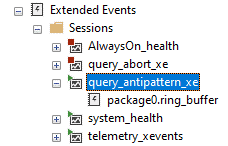
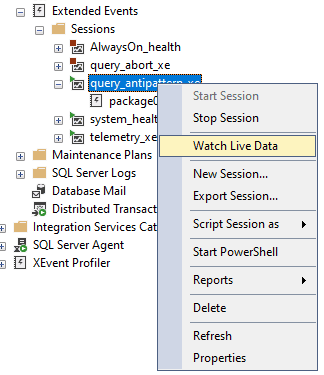

Antipattern #1 – Implicit conversions
|
1 2 3 4 5 6 |
USE WideWorldImporters GO SELECT * FROM Sales.Orders WHERE CustomerPurchaseOrderNumber=10014; |
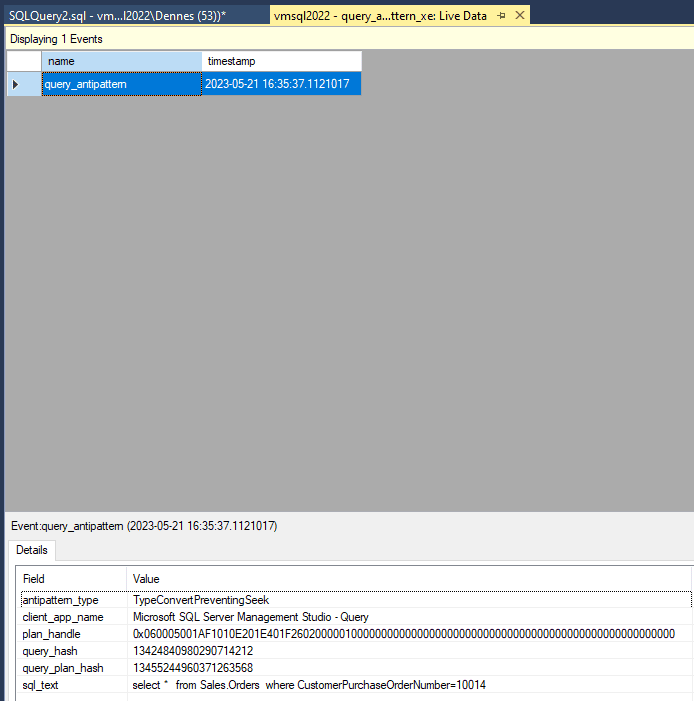
antipattern_type row that this is a TypeConvertPreventingSeekevent. SQL Server is capable of automatically converting data types in a query. The field type is NVARCHAR and the query parameter is INT. Some automatic query conversions prevent the use of index seek, typically where the conversion may be lossless. 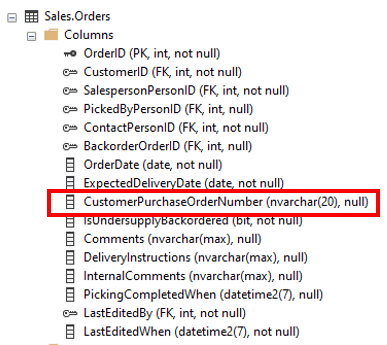
CustomerPurchaseOrderNumber column is converted to an integer for the comparison. Each row has to be converted, so the index cannot be used. Relying on automatic data type conversions in predicates is considered an anti-pattern. If any value in the column was not able to be converted to an INT value, the query would have failed.WHERE CustomerPurchaseOrderNumber=CAST('10014' as char(10)); you will still see the implicit conversion, but since the ASCII value can be losslessly changed to a UNICODE value, the index can be used, and no anti-pattern event is raised.Antipattern #2 – Large IN expressions
To demonstrate this antipattern, I will use the following query that has 150 items in the IN expression of the WHERE clause.
|
1 2 3 4 5 6 7 8 9 10 11 12 13 14 15 16 |
SELECT * FROM Sales.Orders WHERE CustomerPurchaseOrderNumber IN ( 10001,10002,10003,10004,10005, 10006,10007,10008,10009,10010,10011,10012,10013,10014,10015,10016,10017, 10018,10019,10020,10021,10022,10023,10024,10025,10026,10027,10028,10029, 10030,10031,10032,10033,10034,10035,10036,10037,10038,10039,10040,10041, 10042,10043,10044,10045,10046,10047,10048,10049,10050,10051,10052,10053, 10054,10055,10056,10057,10058,10059,10060,10061,10062,10063,10064,10065, 10066,10067,10068,10069,10070,10071,10072,10073,10074,10075,10076,10077, 10078,10079,10080,10081,10082,10083,10084,10085,10086,10087,10088,10089, 10090,10091,10092,10093,10094,10095,10096,10097,10098,10099,10100,10101, 10102,10103,10104,10105,10106,10107,10108,10109,10110,10111,10112,10113, 10114,10115,10116,10117,10118,10119,10120,10121,10122,10123,10124,10125, 10126,10127,10128,10129,10130,10131,10132,10133,10134,10135,10136,10137, 10138,10139,10140,10141,10142,10143,10144,10145,10146,10147,10148,10149, 10150); |
|
1 2 3 |
SELECT * FROM Sales.Orders WHERE CustomerPurchaseOrderNumber IN ( ); |
|
1 2 3 |
SELECT STRING_AGG( CustomerPurchaseOrderNumber,',') FROM ( SELECT DISTINCT TOP 150 CustomerPurchaseOrderNumber FROM Sales.Orders) Orders; |
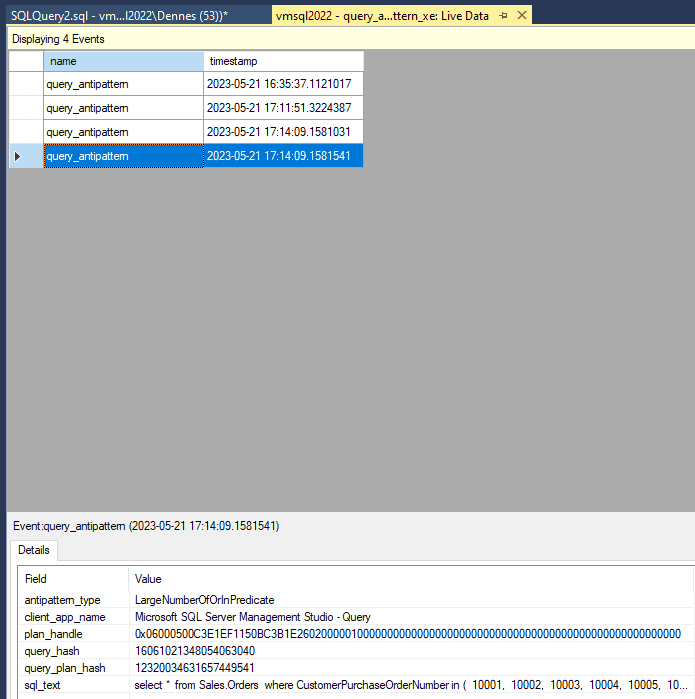
LargeNumberOfOrInPredicate. The IN predicate in fact is translated as a series of OR logical conditions which cannot be optimized, resulting in this anti-pattern. Part of why this is noted as an anti-pattern is that the TypeConvertPreventingSeekevent occurs as well because we are again comparing NVARCHAR to INT types. IN expression to use a character type (either Unicode or ASCII), you will not get the warning because just like with the previous example, if it has no direct negative on the optimization of the query, it will not raise the event. You can generate the IN expression as Unicode values using the following query:|
1 2 3 |
SELECT STRING_AGG( 'N''' + CustomerPurchaseOrderNumber + '''',',') FROM ( SELECT DISTINCT TOP 150 CustomerPurchaseOrderNumber FROM Sales.Orders) Orders; |
Identifying Additional Anti-Patterns
antipattern_type field. We can get the possible values of the antipattern_type field from the extended events system tables and in this way identify what are the possible anti-patterns this event can track.|
1 2 3 |
SELECT map_value FROM sys.dm_xe_map_values WHERE name = N'query_antipattern_type'; |
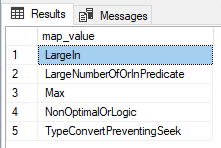
- TypeConvertPreventingSeek and LargeNumberOfOrInPredicate: These are the two anti-patterns we tested
- LargeIn: The name explains a lot, but when executing a query with a lot of values in an
INexpression, the anti-pattern identified is the LargeNumberOfOrInPredicate. It’s not clear what makes theLargeInto be identified. - Max and NonOptimalOrLogic : There is not enough documentation about these two.
Azure SQL Databases
Conclusion
SELECT * FROM sys.database_principals; will cause an implicit conversion (Query_Antipattern_Type: TypeConvertPreventingSeek) event to occur. Aaron provides some advice on how to set up your events that can help mitigate the noisiness.




Load comments